The Impact of Foils on Kiteboarding Performance and Techniques
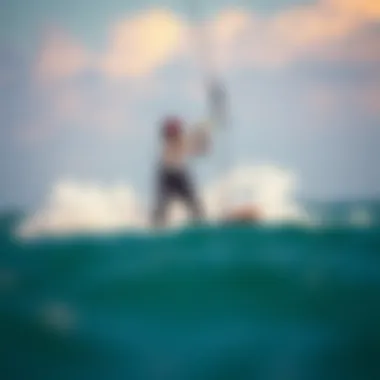
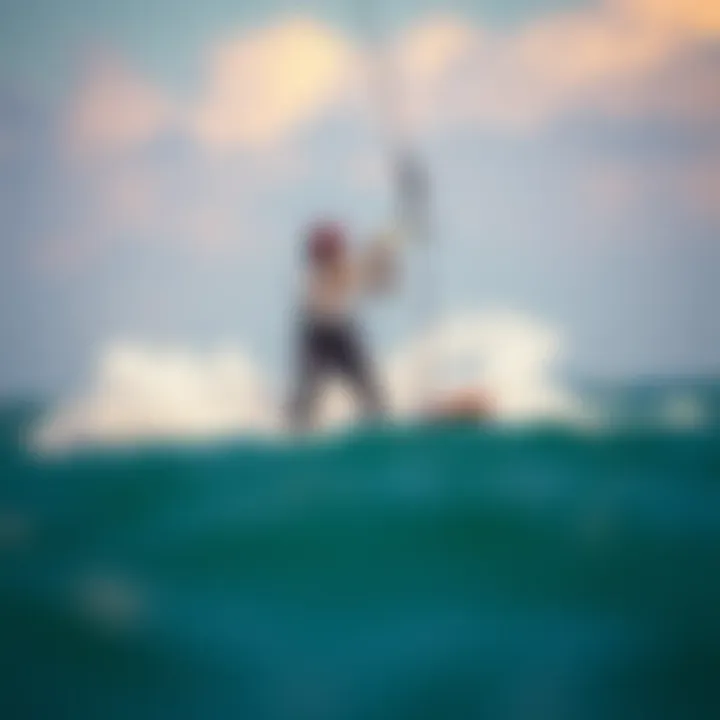
Intro
Kiteboarding has evolved significantly over the years, captivating enthusiasts with its thrill and versatility. Among the critical components of this sport, foils have gained notable traction. These ingenious devices play a pivotal role in enhancing performance, ensuring efficiency, and broadening the horizons of what kiteboarders can achieve. They facilitate a smoother ride over both water and land, offering riders unprecedented levels of speed and control.
Understanding foils isn't just about the technology; it's about embracing a whole new way of interacting with the environment. Whether you’re gliding over glassy waters or slicing through waves, the right foil can elevate your kiteboarding experience dramatically.
This guide will dissect the intricate world of foils, diving into the specifics of design, functionality, and selection, with practical advice to cater to kiteboarders of all skill levels. From novices looking to find their footing to seasoned riders seeking to push boundaries, we aim to provide a holistic view of how foils can transform your time on the water.
By the end of this exploration, kiteboarders will not only appreciate the grace of foils but also learn how to integrate them into their riding strategy effectively. Let's unravel the complexities hidden within the world of kiteboarding foils, ensuring you have all the knowledge needed to glide with confidence.
Prologue to Foils in Kiteboarding
Foils represent a substantial shift in the kiteboarding landscape, revolutionizing the way riders interact with water and air. As kiteboarding enthusiasts explore the dynamic relationships between these two elements, foils stand out as game-changers that alter performance and riding experiences drastically. Understanding their fundamental role becomes essential not just for competitive riders, but also for recreational kiteboarders who crave enhanced efficiency and speed.
Understanding Kiteboarding Foils
In the simplest terms, kiteboarding foils are specialized boards fitted with underwater wings, designed to lift the rider above the water’s surface. Much like how an airplane wing creates lift, a kiteboarding foil uses hydrodynamic principles to achieve a smoother ride, fundamentally altering how riders navigate waves and chop.
The design of these foils is intricate, combining lightweight materials and unique shapes to maximize performance. Some foils are constructed with carbon fiber, while others utilize aluminum or even a combination of both. The choices often impact durability, speed, and overall handling, making comprehension of these elements vital for anyone interested in the sport. Being acquainted with how foils function allows kiteboarders to optimize their rides, enhance their skills, and engage with the water in a more profound way.
The Evolution of Foiling in Kiteboarding
Since the inception of kiteboarding, the evolution of foiling has been nothing short of remarkable. Initially, kiteboarding was all about speed and power, with riders relying solely on traditional boards that skimmed the surface. However, in the early 2000s, the sport began to see a gradual shift toward foiling, prompted by the desire for increased performance in various conditions.
This transformation can be attributed to advancements in materials technology and design methodologies. Inventors and industry enthusiasts started experimenting with different wing shapes and sizes, paving the way for tailored foils suited to individual riding styles. As foiling gained popularity, notable influences from other sports, such as windsurfing and surfing, began to merge into kiteboarding, enriching the overall technique and offering new avenues for exploration.
Today, foiling is more than just a trend; it has birthed its own community within kiteboarding, rife with competitions and social gatherings centered around the craft. Riders now share a common interest that goes beyond mere thrills, often engaging in conversations about technical aspects and performance optimization. From beginner endeavors to professional competitions, the growth of foiling signifies an enduring evolution that continues to attract kiteboarders around the globe.
"Foiling makes every session an adventure; it allows you to discover the ocean in ways you never thought possible."
The dynamics of foiling not only demand a fresh outlook on equipment but also invite fresh perspectives on riding. As kiteboarding moves forward, embracing foils becomes essential for anyone looking to stay at the forefront of this exhilarating sport.
Types of Foils
The type of foil you choose in kiteboarding greatly influences your experience on the water. Selecting the right foil isn't just about which one looks cool; it has a significant impact on performance, maneuverability, and even your enjoyment. Various components of foil design such as fuselage, wing shapes, and stabilizers come into play here, each offering distinct advantages and considerations. If you’re serious about improving your kiteboarding skills, understanding these different types and how they function will be crucial.
Fuselage Designs
The fuselage is the backbone of the foil, connecting the board and the wings. It's not just a simple rod; it plays a major role in the overall stability and handling of the foil. A well-thought-out fuselage design facilitates smoother rides and minimizes drag.
- Short Fuselage: Often favored for tricks and agile maneuvers, short fuselages allow for quicker turns. They provide a more responsive feel but can sometimes make the board feel unstable at high speeds.
- Long Fuselage: These contribute to enhanced straight-line stability, an important factor if you're looking to speed up or ride in choppy waters. However, they can limit your ability to turn sharply, which might not be ideal for every rider's style.
It's crucial to think about what kind of riding you plan to do. Are you aiming for speed and long-distance rides, or is your goal to pull off tricks and maneuvers? The fuselage design plays a significant role in how each ride unfolds, so consider your objectives carefully.
Wing Shapes and Their Effects
Wing shape is another game-changer when it comes to performance on the water. Just like with airplanes, the design of your wing will determine your lift, drag, and overall efficiency.
- High Aspect Ratio Wings: These have a longer and narrower design, which is excellent for maximizing speed and minimizing drag. However, while these wings might make your ride quick, they can be a bit tricky to manage, especially for newcomers. Having to balance speed and stability requires practice and skill.
- Low Aspect Ratio Wings: On the flip side, these wings are broader and shorter. They offer increased lift and less drag at lower speeds, making them fantastic for beginners who are still mastering the basics of foiling. Yet, they might not provide the same efficiency at higher speeds compared to their high aspect counterparts.
Understanding how each wing shape affects your ride will allow you to select a foil that complements your riding style and goals.
Stabilizers and Their Role
Stabilizers might be less talked about than wings and fuselages, but don’t underestimate their importance. Stabilizers help with balance, especially when riding at varying speeds.
- Fixed Stabilizers: These are permanently attached to the foil, providing consistent performance during your rides. They help maintain stability but might limit your ability to customize or change them based on riding conditions.
- Adjustable Stabilizers: Conversely, these can be repositioned according to specific needs. If you're an advanced rider looking for flexibility, these stabilizers can be a boon. Adjusting them based on wind conditions or ride style can enhance control significantly.
Consider stabilizers like the training wheels on a bike; they offer support at crucial stages while allowing you to gain confidence in your skills.
"Choosing the right type of foil is like finding the perfect partner in crime for your kiteboarding adventures—it's about compatibility and enhancing your experience on the water."
By examining the various types of foils in terms of fuselage designs, wing shapes, and stabilizers, you can make informed decisions that align with your kiteboarding ambitions. Remember, the goal is to find what feels right for you, as the best choice can vary greatly from one rider to another.
Benefits of Using Foils
Using foils in kiteboarding comes with numerous advantages that can significantly alter the rider’s experience on the water. These benefits extend beyond simply gliding over the surface; they play a crucial role in enhancing overall performance and enjoyment. As kiteboarding evolves, understanding these advantages helps both novice and experienced kiteboarders make informed decisions about their gear.
Increased Speed and Efficiency
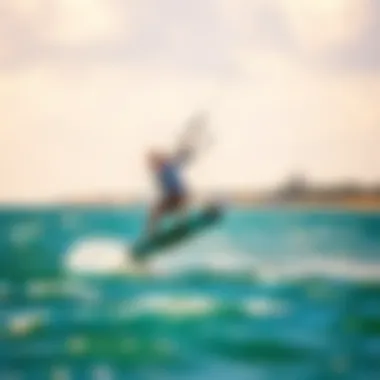
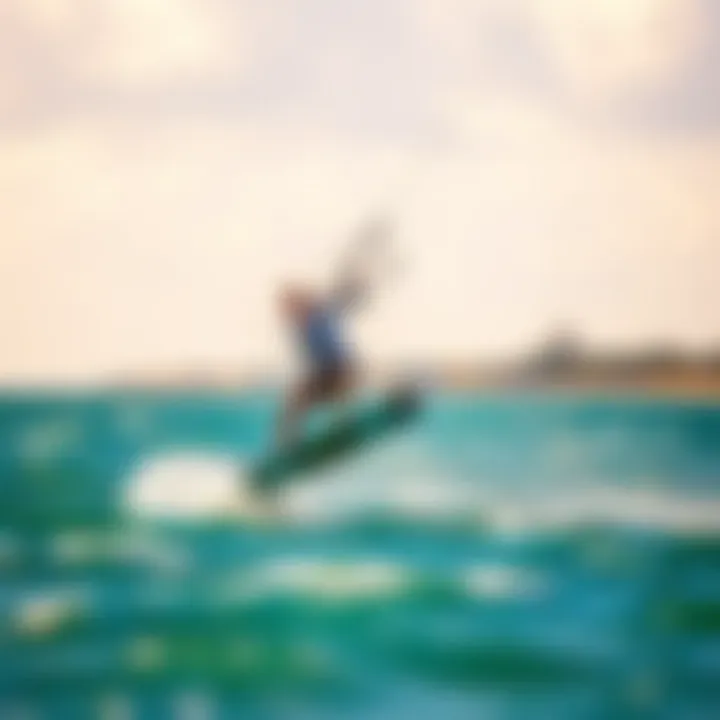
One of the primary benefits of foils is the increase in speed and efficiency they offer. Foils are designed to lift the board above the water, minimizing drag considerably compared to traditional boards. This lift allows riders to harness the power of the wind more effectively, resulting in faster speeds, especially in lighter winds.
- Less Resistance: Unlike conventional boards that sit flat on the water, foils ride above it. This elevation reduces water resistance, allowing for a smoother ride and quicker acceleration. Riders can get up to speed with less effort, making their sessions much more enjoyable.
- Longer Riding Times: With a greater efficiency, riders find they can stay on the water longer, even in variable wind conditions. Not having to rely solely on strong winds means those who also want to engage in freestyle tricks or long-distance rides can do so without feeling hindered.
"Foiling is like flying you’re harnessing the wind and riding it rather than battling the water below."
Enhancements in Maneuverability
Foils also enhance maneuverability, transforming how riders navigate waves and transitions. The height above the water gives riders a unique perspective and allows for sharper turns that would be challenging on a traditional board. This new technique brings a level of freedom and creativity to the sport.
- Responsive Handling: Riders notice that controlling their direction becomes intuitive with a foil. The ability to shift weight and adjust balance translates to instant changes in direction, presenting opportunities to catch waves or perform aerial tricks more easily.
- Fluid Transitions: The elevated position thanks to foiling enables riders to make fluid transitions between moves. For example, hiking up a swell and executing a turn right into another jump feels seamless, heightening the thrill of the ride—creating a dance with the water.
Wave Riding Potential
Many enthusiasts are drawn to kiteboarding for the thrill of wave riding, and foils significantly amplify this experience. Riding on a foil can completely transform how a rider engages with the ocean’s swells, offering a different thrill and sensation.
- Gliding Over Waves: Instead of crashing down into the waves, foiling allows riders to glide above them. This means that even smaller waves can be utilized for adrenaline-pumping rides without the fear of getting tossed around.
- Extended Wave Interaction: Foils enable kiteboarders to ride waves longer and at a higher speed than traditional setups. With a foil, it’s possible to catch waves earlier and stay on them longer, optimizing the riding experience. Riders ride the swell's energy effortlessly, making it feel almost like flying over water.
In summary, the benefits of using foils in kiteboarding cannot be understated. Increased speed and efficiency, enhanced maneuverability, and expanded wave riding potential all contribute to a more exhilarating experience on the water. For anyone looking to push their limits in kiteboarding, understanding and applying these benefits is vital.
Choosing the Right Foil
When it comes to kiteboarding, selecting the right foil can make or break your experience on the water. A suitable foil isn’t just about racing speed; it’s about enhancing your overall ride, matching your style, and ensuring safety. As kiteboarding continues to evolve, having the right equipment that complements your skillset is more crucial than ever. This section breaks down essential factors to consider when choosing a foil, ensuring you’re well-equipped to make informed decisions.
Assessing Skill Level and Riding Style
Your skill level and riding style play pivotal roles in determining the ideal foil for your needs. Beginners might want a foil that’s stable and user-friendly; think of it as the trusty steed that gives you a smooth ride across the water. These foils typically come with wide wingspans for greater lift, allowing for easier takeoffs and landings.
On the other hand, experienced kiteboarders might need something that aligns with advanced maneuvers and high-speed performance. These riders might opt for smaller, more agile wings that enable sharp turns and tricks, catering to a more aggressive riding style. Factors such as weight, wind conditions, and personal preferences can also play a part:
- For Beginners:
- For Advanced Riders:
- Stable foils with larger wings for increased lift.
- Foils designed to withstand rougher beginner mistakes.
- Options that lessen the risk of crashing.
- Smaller foils that reduce drag.
- Materials that allow for rapid response to shifts in weight.
- Foils designed for high-speed pursuits and complex tricks.
Foil Sizing Guidelines
When it comes to foil sizing, one size does not fit all. Picking the right size foil is crucial for balancing performance and control. Larger wings can be beneficial in lighter wind conditions, as they offer more lift, whereas smaller wings excel in stronger winds, providing speed and precision. Here’s a broader look at some sizing pointers:
- Large Foils (above 2000 cm²):
- Medium Foils (1500 - 2000 cm²):
- Small Foils (below 1500 cm²):
- Great for beginners and light wind scenarios.
- Offer more stability, reducing the chance of nose dives.
- Suitable for intermediates looking to balance lift and speed.
- Good for varied wind conditions.
- Best for advanced riders aiming for high-speed performance.
- Ideal for high-wind conditions and expert-level tricks.
It's advisable to consult with local experts or fellow kiteboarders to determine what sizes suit their riding conditions best.
Materials and Construction Quality
The construction quality and materials used in a foil can significantly impact its performance and durability. The typical materials for foils are aluminum and carbon fiber, with carbon being recognized for its lightweight yet stiff properties. Although pricier, carbon foils can offer superior performance—especially when it comes to responsiveness and speed.
Moreover, the build quality overall can dictate how long your foil lasts and how it handles under pressure. A well-made foil can make the difference between a thrilling ride and a frustrating experience. When shopping for a foil, consider:
- Material Selection:
- Construction Techniques:
- Brand Reputation:
- Aluminum: More affordable but heavier; good for beginners.
- Carbon Fiber: Lighter and offers advanced performance at a higher price.
- Look for foils with reinforced joints and quality finishing to ensure longevity.
- Trustworthy brands often adhere to higher manufacturing standards.
By investing time in selecting the right foil—considering size, materials, and your personal skills—you set yourself up for a more enjoyable experience on the water. As this sport continues to evolve, your choices will ultimately determine how well you adapt and thrive in challenging conditions.
Techniques for Riding Foils
Understanding the right techniques for riding foils can make all the difference in the kiteboarding experience. Mastering these techniques not only enhances performance but also builds confidence on the water. Foiling opens up new avenues for excitement, and knowing how to maneuver effectively allows riders to explore these possibilities fully. This section dives into crucial riding techniques, providing you with insights and methods that can elevate your foiling skills.
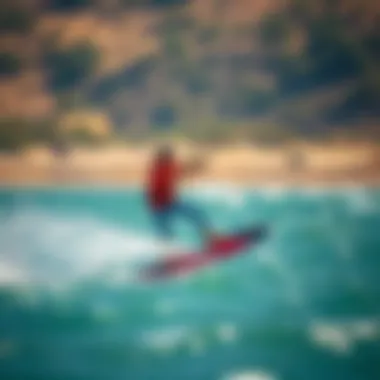
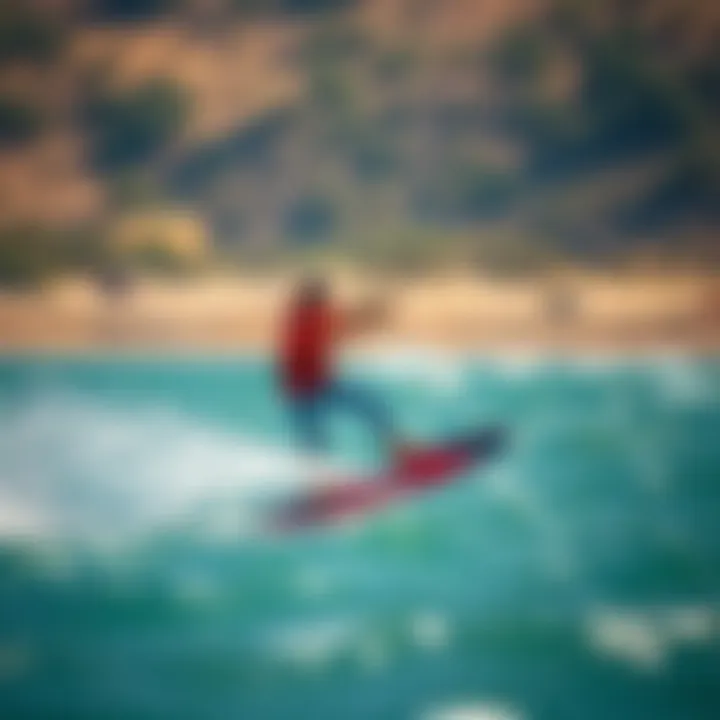
Getting Started with Foiling
Starting off with foiling might feel like stepping onto a tightrope for the first time. It's understandable to have mixed feelings of anticipation and anxiety. As a beginner, it’s essential to get your bearings before diving headfirst into the waves. Here are a few pointers to ease the transition:
- Body Positioning: Your stance matters immensely. Keep your weight centered and bent knees to maintain balance.
- Kite Control: Familiarize yourself with your kite. Start with gentle power, gradually increasing as you feel more stable.
- Water Start: Begin by practicing the water start. Push against the board to let the foil begin to lift, then carefully lean back, allowing the kite to pull you up.
Each attempt builds your muscles for stability and develops your instincts for gauging the right pull from the kite. Remember, it’ll take some time to find your sea legs. Stay patient and focus on enjoying the process.
Mastering Takeoff and Landing
Takeoff and landing can be the trickiest parts of foiling, akin to a dance that requires rhythm and timing. Here are some essential tips:
- Takeoff: As you prepare to take off, it’s crucial to gauge the water surface. A smooth approach allows the foil to lift gracefully. Make sure to lean back slightly and maintain pressure on the tail, so the front foil rises smoothly from the water.
- Landing: The landing phase often sends shivers down even the most seasoned rider’s spine. As you approach the water, start getting your feet closer to the board. Prepare to gently lower the foil back into the water to avoid a heavy slap that can throw you off balance.
Practicing takeoffs and landings in controlled conditions makes a significant difference in your overall confidence. It’s like learning to ride a bike; the more you practice, the steadier you become.
Advanced Maneuvers with Foils
Once you’ve nailed the basics, you’ll likely want to spice things up with some advanced tricks. Foils lend themselves to unique maneuvers that can impress both yourself and onlookers. Here are a few to consider:
- Jumps: With the right technique, takeoff can be transformed into jumps. Approach with speed, and as you lift off, pop the board downward while pulling the kite high.
- Transitions: These involve switching directions while staying on the foil. Shift your weight to your back foot and steer the kite to change angles smoothly. An effective transition not only looks stylish but also conserves energy.
- Carving Turns: Once you've mastered basic turns, hitting that carving motion can heighten your ride. Lean into your turns more sharply, maneuvering the kite to maintain lift. The smoother the carve, the better your control.
Practice is Key: The more you experiment with these tricks, the more seamlessly they will come to you. Try to record some sessions; watching yourself can reveal growth and areas for improvement.
"Foiling is not just about speed, it’s about the grace of gliding. Each move teaches you a little more about yourself and the flow of the water."
Foil Maintenance and Care
Foil maintenance and care are critical components that every kiteboarder need to embrace if they aim to keep their equipment performing optimally. Just like a fine-tuned sports car requires regular checks and services, your foils need attention to ensure both performance and longevity. Foils, while designed to withstand the rigors of water and wind, are not immune to wear and tear over time. Proper maintenance can mean the difference between a thrilling ride and an abrupt trip to the repair shop.
Routine inspections and suitable storage methods will not only prolong the lifespan of your foil but will also enhance safety during your rides. Failing to keep an eye on your equipment could lead to unfortunate mishaps, or your foil not functioning as intended, which can spoil an otherwise perfect day at the beach.
Routine Inspection Practices
Performing a routine inspection of your foils is not just for the paranoid; it’s a wise practice for any enthusiast. Here are key areas to focus on:
- Check the Wings: Look for any visible damage or wear on the wings. Minor scratches might seem harmless but could affect performance.
- Inspect the Fuselage: Ensure the fuselage is intact, as any cracks can compromise the structural integrity.
- Look at the Bolts and Screws: Check for corrosion and tightness. Loose screws can lead to parts detaching during a ride, which would be disastrous.
- Assess the Masts: Inspect for any bends or breaks. A deformed mast can alter the foil’s balance.
- Foil Surface: Regularly clean the surface to prevent any build-up of salt or sand that could impact performance.
These routine checks should be part of your pre-ride preparation. With just a few minutes dedicated to these inspections, you can save yourself a heap of trouble.
Storage Recommendations
Where and how you store your foils is paramount in extending their lifespan. After your adventurous day on the water, consider the following storage tips:
- Keep Dry: Ensure your foil is completely dry before storage. Moisture can lead to corrosion, particularly on metal parts.
- Temperature Control: Store your foils away from extreme temperatures. Excessive heat or cold can warp or stress the materials.
- Use Protective Covers: If possible, use storage bags or covers to shield your foils from dust and other environmental elements.
- Avoid direct sunlight: Prolonged exposure to sunlight can degrade materials, especially plastics and fabrics.
Good storage practices not only help maintain the integrity of the equipment but also ensure that every time you hit the water, your setup is ready to perform at its best.
"A well cared-for foil is like a trusted friend on the water; it’ll take you places you never thought possible."
By making maintenance a routine part of your kiteboarding experience, adopting simple inspection practices, and ensuring proper storage, you contribute greatly to the performance, safety, and longevity of your foils. Thus, you’re not just investing in equipment but cultivating a sustainable relationship with your sport.
Foil Technology Innovations
The landscape of kiteboarding is changing rapidly, and a significant part of that evolution is the advent of innovative foil technology. In this section, we’ll dissect how modern advancements are shaping the way enthusiasts experience the sport, highlighting important considerations and benefits. Each new element in foil construction and design is a step toward improving performance and rider satisfaction, making it a critical aspect of today’s kiteboarding adventure.
New Materials and Designs
The materials and designs used in foil manufacturing have undergone revolutionary changes in recent years. Traditionally, foils were crafted predominantly from aluminum or outdated composite structures. However, with the introduction of advanced carbon fiber composites, rigs have become lighter and substantially stronger.
For instance, many brands are using a fusion of carbon and other fibers to optimize weight and strength. This transition not only enhances durability but allows for greater response to rider inputs, resulting in a ride that feels more connected to the water.
To outline some new materials:
- Carbon Fiber: Exceptional strength-to-weight ratio.
- High-Density Foam: Improving flotation and stability.
- Reinforced Plastics: Offer flexibility while resisting impact in potential mishaps.
The designs themselves have also transformed. Consider the increasing emphasis on streamlined shapes that reduce drag, allowing riders to slice through the water with ease. Foils are now equipped with wing profiles designed to enhance lift while minimizing resistance. Innovations such as adjustable wings and modular designs enable custom setups that cater to different skill levels and riding styles. These designs not only appeal to performance seekers but also to those new to foiling, as they allow for easy adjustments as skills develop.
Impact of Technology on Performance
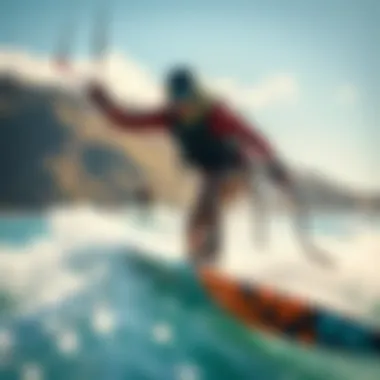
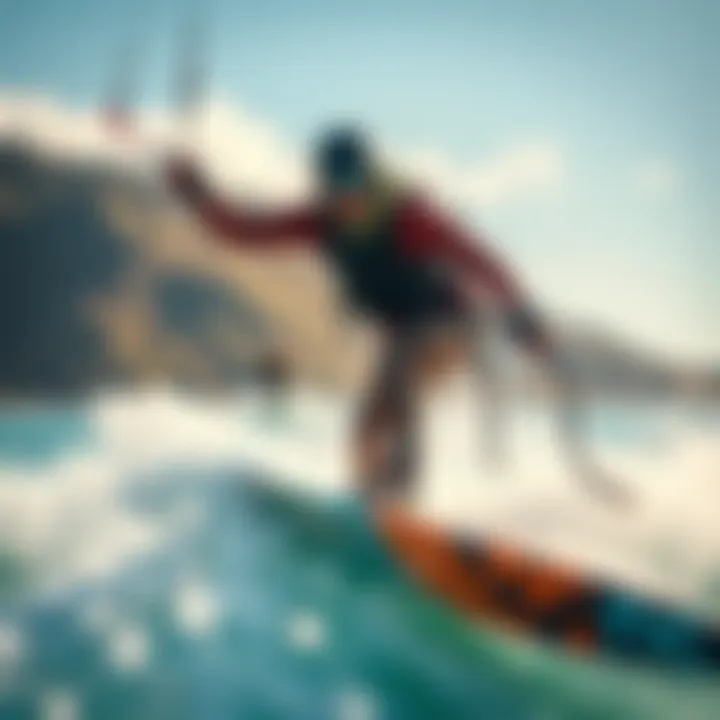
The stakes are high in kiteboarding; performance can often hinge on the right blend of technology and rider proficiency. Advanced foil technology directly influences speed, control, and overall ride quality. One of the most noticeable impacts is in the area of speed. With cutting-edge designs, riders can achieve higher velocities without needing excessive wind, making the kiteboarding experience much more accessible across different conditions.
"Technology not only enhances speed but breeds confidence, allowing even novices to feel more secure on foils."
Moreover, the integration of smart technologies and sensors is on the rise. Some foils are now incorporating digital components that provide real-time feedback on rider performance. This can be a game-changer, enabling riders to adjust their techniques based on tangible data, thus providing invaluable information on optimal angles, speed, and lift.
The advancements also encourage safety features. Enhanced stability and maneuverability reduce the likelihood of falls and accidents, essential factors for many riders who might be apprehensive about taking the plunge into foiling. These innovations combine to create a more enjoyable and less daunting experience, paving the way for wider adoption of foiling in the kiteboarding community.
Foiling Safety Considerations
Foiling offers a unique thrill, creating an exhilarating experience that can elevate kiteboarding to new heights. However, with great adventure comes inherent risks. Understanding foiling safety considerations is essential for both newbies and seasoned riders alike. Proper safety measures not only protect you but also contribute to a more enjoyable outing on the water. Therefore, being well-informed is a crucial part of honing your skills as a kiteboarder.
Understanding Foil Risks
While foiling can be an incredible way to glide across the water, it's important to acknowledge various risks involved. The dynamic nature of foiling means that riders can easily find themselves in unpredictable situations.
- Drowning: This is a serious risk that any water sport participant must consider. Losing control of your foil can lead to rapid descents into the water.
- Collisions: Foils are sharp and can pose a serious hazard not just to the rider but also to others in the water. A sudden gust of wind or miscalculated maneuver can potentially lead to collisions.
- Injury from Falling: The act of heightening above the water surface can lead to sudden falls that may cause injury. Falling from a height can cause serious injuries, particularly to the neck or back.
- Equipment Failure: Just like any sport, sometimes things can go wrong. A frayed line or weak connection in your foil could lead to unexpected failures, so vigilance is key.
As potential hazards exist, it is imperative for riders to take proactive measures. Educating yourself about these risks and preparing accordingly can significantly minimize dangers associated with foiling.
Safety Gear Recommendations
Taking precautions is a fundamental aspect of safe foiling. Wearable safety gear can make a difference in exercising caution while you navigate the waves. A few key pieces to consider include:
- Helmet: A well-fitting helmet can protect you from head injuries if you fall or hit something in the water. It's advisable to choose a model designed specifically for kiteboarding.
- Impact Vest: This protective gear can absorb shocks from falls and prevent injuries to the ribs and back. It can also provide some flotation, which is always a plus.
- Wetsuit or Drysuit: These suits offer thermal protection, as they keep you warm, especially in colder waters. They also protect you from abrasions that you might encounter while foiling.
- Safety Leash: A safety leash may prevent your board from drifting away if you spill, making it easier to retrieve your gear and reducing the chance of collision with other riders.
- PFD (Personal Flotation Device): Wearing a certified PFD can be a life-saver in case of emergencies. Pick one that allows for freedom of movement without sacrificing safety.
"An ounce of prevention is worth a pound of cure." Taking safety seriously ensures your kiteboarding experience remains enjoyable and free from mishaps.
Community and Culture of Foiling
Kiteboarding, especially the foiling aspect, is not just a sport; it encompasses a vibrant culture and a connected community. The importance of community in foiling cannot be understated, as it brings enthusiasts together, fostering an environment where knowledge, skills, and experiences are shared and celebrated. This sharing helps spread the joy of foiling and cultivates a spirit of camaraderie, making the learning process less daunting and much more enriching.
Connecting with Other Foil Enthusiasts
Connecting with fellow foil enthusiasts can provide a wealth of benefits. Whether one is just starting out or a seasoned rider, the exchange of ideas and experiences plays a big role in progressing in this thrilling sport. Joining local groups, clubs or online forums dedicated to kitefoiling opens up avenues to meet like-minded people.
Participating in community-driven events, such as group rides or organized beach clean-ups, can result in lasting friendships. These interactions often lead to mentorship opportunities, where more experienced riders can offer tips on techniques or equipment choices. Finding a local community can also help during those challenging early days when understanding the nuances of foiling might feel overwhelming.
- Sharing techniques, tips, and tricks can help each other to progress.
- Engaging with others also adds a social dimension to the sport, making it more enjoyable.
- There’s a sense of belonging that comes from being part of a group with shared interests.
Foil Competitions and Events
Foil competitions have gained traction over recent years, acting as milestones for athletes of all skill levels. These events not only showcase individual talent but also foster a sense of unity within the community. Competitions range from local gatherings at popular kiteboarding spots to international events that draw participants from all over the globe.
These competitions keep the spirit of the sport lively and motivated. Riders can challenge themselves, pushing beyond their limits in a healthy and supportive environment. Moreover, such events often serve as platforms where innovative techniques and equipment can be put to the test. Not only does the competition help riders hone their skills but the camaraderie built in these circumstances is invaluable.
"Community is like wind; you can feel it, but you can’t see it. The connections fuel your ride, pushing you forward, unseen but vital."
In summary, being part of the foiling community enhances not only the shared learning experience but also the overall enjoyment of the sport. Engaging in groups, connecting with other enthusiasts, and participating in competitions allows kiteboarders to thrive. These elements of community and culture enrich the kiteboarding journey, ensuring that each step taken is one that makes the ride even more memorable.
Future of Foiling in Kiteboarding
The realm of foiling in kiteboarding is at the cusp of transformative change. As advancements in technology and materials burgeon, they promise not only to enhance performance but also to redefine the very experience of kiteboarding itself. With the kiteboarding community becoming increasingly aware of the importance of sustainability and innovation, the future of foiling holds a wealth of opportunities for those who ride the wind and water.
The Next Wave of Innovations
Looking ahead, it's clear that innovation will continue to shape the landscape of foiling. Manufacturers are dedicating themselves to developing foils that are lighter and stronger. One notable aspiration among designers is to create wing shapes that ensure more lift with less drag.
- Smart Foiling Technology: We might soon see foils equipped with sensors that provide real-time feedback to help riders optimize their performance. Imagine adjusting your position based on data regarding wind speed and water conditions—this level of detail could revolutionize how we approach each session.
- Advanced Materials: Biodegradable composites and flexible materials could soon replace traditional constructions, paving the way for a greener approach to foiling. The focus will not only be on performance but also on making sure that the equipment we use is kind to our planet.
"The next wave of innovations in foil design may change how we understand performance and sustainability in kiteboarding."
This evolution will definitely cater to both seasoned pros and newcomers in the sport. We might also see a rise in adaptive foils that cater to different riding styles, making the sport more inclusive. Industry developments point towards a future that celebrates not just the thrill of riding, but also a more considerate approach to our environment.
Sustainability Trends in Foiling Equipment
The push for sustainability in sports equipment, including kiteboarding, is more than just a trend—it's a necessary evolution. As kiteboarders become more eco-conscious, the demand for sustainable foiling equipment is growing.
- Recycling Initiatives: Many companies are starting to introduce recycling programs for old foils and boards, reducing waste and giving new life to materials. This practice not only supports environmental sustainability but also fosters a sense of community among riders.
- Eco-Friendly Manufacturing: Brands are experimenting with sustainable materials, such as recycled plastics and bamboo, as alternatives to conventional materials. This not only decreases the carbon footprint of production but also aligns with the values of many kiteboarders.
- Awareness and Education: More educational programs are being established to inform kiteboarders about the impact of their gear on the environment. Workshops and discussions at sporting events are creating a platform for a culture of responsible riding alongside performance.
As sustainability becomes entrenched in the ethos of kiteboarding, riders can look forward to enjoying the thrill of foiling while also being stewards of the environment. The future of foiling is not just about speed and agility—it's about forging a lasting connection with nature.







